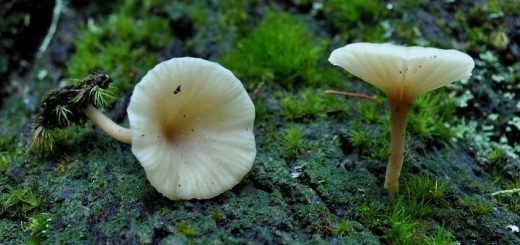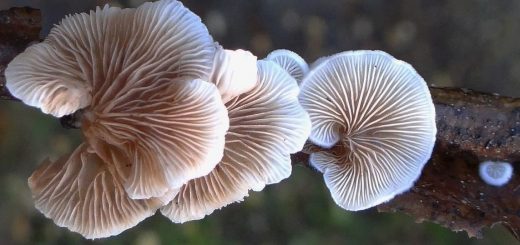#140: Morchella angusticeps, the Black Morel of Eastern North America [Archived]
Note: This is an archived post. You can read the current version of this post here.
Black morels can be distinguished from yellow morels by their dark ridges and light pits. Other morels have light ridges with darker (or only slightly darker) pits. Morchella angusticeps is the most widespread black morel in North America. It can be found almost anywhere east of the Rocky Mountains, although it is not as common as yellow morels.
In Virginia, morel season is over already. Thanks to bouts of cold and wet weather followed by periods of warm and dry weather (it was never warm and wet), the Washington, D.C. area saw very few morels this year. Those of you in northern states – particularly at higher elevations – might still be able to find morels this year. And morels can probably still be found on the west coast because mushrooms don’t care as much about seasons in that part of the country.
Black morels, in particular, were hard to come by this year. How can you identify a black morel? Simple: the edges of the ridges are darker than the pits. For those of you not familiar with morels, here is a short refresher on what a morel looks like. The closest thing to which I can liken a morel is a pinecone on a pedestal. Morels are made up of two sections: a head and a stipe. The stipe can be lobed but is generally straight and holds up the head in a roughly vertical orientation. The head is conical to oval (depending on the species) and is characterized by a network of irregularly-shaped ridges and pits. Although they are irregular, the ridges and pits are well-defined, unlike their look-alikes such as Gyromitra esculenta, which have smaller “ridges” that are more like wrinkles. Morels are also hollow on the inside and the stipe is attached to the head anywhere from its base to halfway up the head. Gyromitra species are chambered in the center and attached to the stipe only at the top of the head.
The main feature differentiating M. angusticeps from other morels is the fact that its ridges are darker than its pits. Its ridges start out brown or tan and darken to dark brown or nearly black while its pits start out yellowish brown and largely retain that color as the mushroom ages. For most of its range, this is enough information to separate it from other morels. If you want to be absolutely certain, there are other features you can check.
M. angusticeps is rather small for morels, growing only 5-16cm (2-6in) tall and 2-5cm (1-2in) wide. Its head grows 3-8cm (1-3in) tall and is the widest part of the mushroom. It is roughly conical, though it may be flattened at the top and curved in at the bottom to be more egg-shaped. Most of its pits are elongated in a vertical direction, which sets it apart from the haphazardly arranged pits of yellow morels. Where the head meets the stipe is not quite at the base of the stipe. Instead, the head hangs down over the stipe slightly to make a small but noticeable groove.
The stipe grows 2-8cm (1-3in) tall and only 1-3cm (0.4-1in) wide. It is usually the same thickness all the way down, but the base of the stipe is often slightly enlarged. The stipe is yellow brown to tan to pale brown, which makes it roughly the same color as the bottom of the head’s pits. In texture, it is mostly smooth but slightly bumpy or grainy and may develop long furrows, especially in wet weather.
M. angusticeps can be found in North America east of the Rocky Mountains under various hardwoods. This black morel prefers fruiting on the forest floor under hardwoods, particularly tulip trees, white ash, and green ash. Like other morels, M. angusticeps is probably saprobic and mycorrhizal with these trees during different parts of its life cycle. You can find the mushrooms from March through May, usually somewhat before the yellow morels.
There is one other black morel in this part of the world which may be confused with M. angusticeps. If you found your black morel near or above 44° latitude, it could also be M. septentrionalis. The two mushrooms are nearly impossible to tell apart. M. septentrionalis grows 5-7.5cm (2-3in) tall, making it slightly shorter than M. angusticeps. It also has a preference for fruiting near or directly from wood. Additionally, M. septentrionalis has spores that are 20-25 x 11-15µ in size, which makes them slightly smaller than the 22-27 x 11-15µ spores of M. angusticeps.
Like other morels, M. angusticeps is a choice edible. However, all morels must be thoroughly cooked before being eaten. Raw morels contain toxins that will make you sick but which are destroyed by the cooking process.
See Further:
http://www.mushroomexpert.com/morchella_angusticeps.html
http://www.mushroomexpert.com/morchella_septentrionalis.html
M. angusticeps was recently differentiated from the European black morel, M. elata, as well as M. septentrionalis and other North American black morels. The work done by Michael Kuo (author of MushroomExpert.com) with the Morel Data Collection Project was instrumental in verifying these taxonomic changes, so although I only consulted MushroomExpert.com for this post (few other sites discussed M. angusticeps or even black morels in Eastern North America and none had as much detail), the information retrieved from that site is as accurate and up-to-date as possible.
Things I have confused with morels from a long way away: Bear Corn (a.k.a. Squaw Root), solitary Beech Tree leaves, and small and well-decomposed (and thus correctly-sized and deeply pitted) stumps or logs.









![#011: Characteristics of Kingdom Fungi [Archived]](https://www.fungusfactfriday.com/wp-content/themes/hueman/assets/front/img/thumb-small-empty.png)

2 Responses
[…] morels (such as Morchella angusticeps, FFF#140) are the mushrooms that most closely resemble Half-Free Morels. Both of these morels have darker […]
[…] Morels (in Eastern North America, see FFF#140) and Half-Free Morels (FFF#211) can be easily distinguished by their darker ridges and by the fact […]